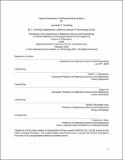Optical Interactions in Self-Assembling Systems
Author(s)
Zornberg, Leonardo Z.
DownloadThesis PDF (7.485Mb)
Advisor
Macfarlane, Robert J.
Terms of use
Metadata
Show full item recordAbstract
Self-assembly of nanoscale components into ordered macroscopic structures is a powerful tool for the fabrication of metamaterials with tailorable or exotic effective material properties. Of particular interest are optical metamaterials, since the lengthscales of the nanoparticle subunits and microscale assemblies match the interacting wavelengths of light. While this overlap offers many opportunities for the fabricated structure to influence light, as well as for light to influence the structure, it also introduces several technical challenges. First, it is inherently difficult to simultaneously control optically relevant nanoscale and microscale structures because the microscale shape is governed by nanoscale interactions. Second, the stochastic nature of self-assembly kinetics introduces structural variability at the microscale that directly leads to variability of the optical properties. Third, only thermodynamically stable features can be consistently (non-stochastically) reproduced in a self-assembled structure, which further limits the types of optical devices that may be assembled. In this thesis, we address these challenges in optical self-assembling systems by exploring two approaches: how light may be used to manipulate the nanostructure and microstructure of a self-assembling system, and how the correlated nanostructure and microstructure can be used to manipulate light. We initially investigate the use of optical processing to induce structural changes in a self-assembled nanoparticle film via local heating and explore the interrelated dynamics of nanoscale reorganization and microscale rearrangement that influence the final morphology of the processed film. Then, we conduct a process study of a self-assembling system to determine the influence of processing conditions on optically relevant features of the assembled structure, including crystallite size and material heterogeneity. Lastly, we develop a process for assembling a diverse array of faceted structures on a surface and demonstrate that the thermodynamically determined facet angles of these structures can be used as tilted mirrors that couple light into the substrate plane. These combined research components span the role of optical interactions in self-assembling systems from start to finish: From controlling assembly conditions, to optical processing after assembly, to using a new self-assembled metamaterial as an optical device.
Date issued
2022-02Department
Massachusetts Institute of Technology. Department of Materials Science and EngineeringPublisher
Massachusetts Institute of Technology